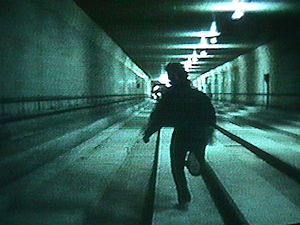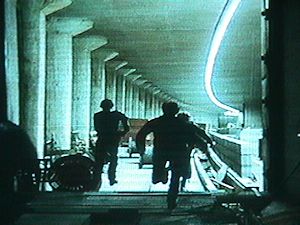2000.11.13
memories of desire?
I wanted to rent Paris, Texas, but it was out, so I rented Spetters and Ulysses' Gaze.
In watching Spetters (14 years since I last did so) I have to report the mistakes I made in my last post about that film. What's funny is the types of mistakes my memory made.
The boys are all 20 years old, (not teenagers). The farmer father does not chase his son on a tractor, rather pulls the "whore of Babylon's" Chevy Impala (I was right about that) out of a roadside ditch that the farmer's son stupidly backed into. The 'puritanical', farmer father does routinely beat his son, however (and the son has a definite sado-masochistic streak to him -- he gets himself 'coiled up' in the 'sub-plot' within the under-construction subway).
 
Only two of the boys are amateur racers, while the farmer's son is an auto mechanic at the gas station.
And here's my favorite memory mistake: it is not extra long hot-dogs that are the most popular item at the "whore's" luncheon business, rather it is 'croquettes' (or something spelled like that) which, unknown to the customers, are made of canned dog food. [Obviously serving the question, "is real fast food actually any better?"]
Overall, I was correct that Spetters is a nimiety of vehicles. It's like Two for the Road on multiple steroids.
After now being well re-acquainted with both films, what's really interesting is the difference the 1970s made. The change in 'style' from Two for the Road (1967) to Spetters (1980) is very noticeable, and the fact that both films are 'vehicular' heightens the changes. There is one very weird coincidence between the two films, however. The station wagon in Spetters is also driven by a family (husband, wife, a boy and a girl), and the hero of the film has his paralyzing motorcycle accident because the husband in the station wagon throws a bag of orange peels out the car window while he's driving. Perhaps it really isn't odd that the station wagon and the nuclear family come to represent conformity in both films, but they also come to represent the 'death' of the free (wheeling) spirit.
 
Alas, I finished watching Spetters and then began to watch Ulysses' Gaze (which I've never seen before but have the soundtrack of for two years now), and the pace went from 75 MPH to 5 MPH. I haven't finished watching the film yet, but it looks like one might be able to analyze the 'vehicles' in it as
well. But it won't surprise me if the notion of "film" itself turns out to be Ulysses' Gaze's primary vehicle.
| |
2000.12.21
errors in "speaking architecture"
Rick ended his last post with:
[Alex]
10. . . . the ARCHITECT SPEAKS THE BUILDING. The building being a statement by him about some referent event and its context and derived by him from a selection of possible (appropriate?) elements and their combinations to represent this event/context. To make a statement...."
..............
I leave off the rest of the message, by letting Alex's statement (immediately above, #10) end the exchange. From the foregoing different modes of thought, what would you say should be the response to #10?
Steve suggested at the end of the post entitled "where does 'concept' come from?" dated 18 December 2000 [just before Alex's quotation above]: Last week I offered www. quondam. com /innuendo as a "display [that generally] deals with the 'language' and meaning of architectural planimetric forms, while specifically [displaying] the 'master key' that unlocks the long held mysteriousness of Piranesi's Ichnographia Campus Martius. ...you see a 'building' [Aedicula Intercorse] that is both literally and figuratively conception. This tiny building is indeed one of the few plans within the Ichnographia that Piranesi does not provide with a Latin label, and that is because the building, through its plan, already speaks for itself, and, moreover, it speaks of all the 'concepts' there involved, namely, Piranesi's conception of architectural language, and the very conception of Rome [Romulus] itself. Piranesi's architectural intensification here is so tight to the point that indeed the medium is the message.
Essentially, Piranesi designed a building deliniating conception, which also represents Piranesi's conception of the large Campo Marzio plan, which also represents the beginning/conception of Rome itself.
And I now wonder whether it might be more worthwhile to seek a language of architecture where the medium is the message, or is such a 1=1 language the same as "a language of architecture that goes beyond appeals to a metaphorical sense of 'language'?"
2000.12.26
Learning from Lacunae
I began working on Learning from Lacunae with the exposition of the two states of the Ichnographia, and so far the results are favorable. There are many images to utilize, so several pages are already planned. It is almost reasonable for me to consider devoting all of Learning from Lacunae to Piranesi’s Campo Marzio, especially with regard to all the “mistakes” of contemporary (modern) scholarship. Plus there is “Inside the Density” and Encyclopedia Ichnographia.
If the whole of Learning from Lacunae is going to be on the Campo Marzio, then I’m going to somehow jazz up the content, rather than produce a completely black and white publication. Just today I found yet another way to colorize graytone images within Corel[?], so there are now many more (color) options to pursue.
One way to experiment with the “look” is to see how the (free) association of hyperlinks might just lead into all kinds of “uncharted” territory. For example, the Ichnographia can lead to reenactment, Kahn, Tafuri, language, promenade, Eisenman, Ichnographia Quondam, Working Title Museum, Collage City, Infringement Complex. Perhaps the way I make transitions could be as “mysterious” as the Ichnographia itself, meaning I could introduce new mysteries while I’m solving old ones. One could think of this as some sort of continual Piranesian theme.
| |
2001.01.04
sixth architectural reference
R. James Aitken, Piranesi-Vico-Il Campo Marzio: Foundations and the Eternal City (Montreal: McGill University, 1995). This is Aitken's Master of Architecture thesis.
I first became aware of Aitken's thesis in late 1996 via an online publication of the thesis' abstract. I did not read the thesis, however, until July 2000, that is, immediately after ordering the thesis through www.contentville.com [I just did a check at contentville and Aitken's thesis is oddly no longer available there]. It was then that I again read the abstract and saw that Aitken's had already connected the notion of reenactment with Piranesi's large plan of Il Campo Marzio. What distressed me was that I had been by that time making much ado about Piranesi's Campo Marzio being a reenactment of the Pagan-Christian inversion of ancient/imperial Rome, yet I was doing so without any reference to Aitken's thesis. Of course, I really could not make any reference to Aitken's work simply because I had not read it, but that does not excuse the lacuna of my research and analysis. Henceforth, let it be clear that R. James Aitken is the first architect to identify Piranesi's Ichnographia Campi Martii as a reenactment.
Aitken also picks up on Piranesi's clues that the Campo Marzio is about Pagan Rome's conversion to Christianity, again a topic that I have been keen on. As with reenactment, however, Aitken is somewhat timid about his convictions in these regards, for the bulk of his thesis deals with the clear possible connection between Vico's "philosophy" and Piranesi's method. Plus Aitken stresses a reading of the Campo Marzio text along with a 'reading' of the large plan. In all, Aitken's thesis is very good, full of many valuable insights, and arguably the first full study of the Campo Marzio done with regard to the context of Piranesi's own time. Aitken's thesis does not follow Manfredo Tafuri's analyses of the Campo Marzio (as do Bloomer, Eisenman, and others), and thus Piranesi-Vico-Il Campo Marzio does not follow in the mistaken interpretations that Tafuri initiated.
With regard to my Campo Marzio research and 'thesis', it is somewhat uncanny that Aitken and I arrive at virtually the same conclusions, yet we come to the conclusions from distinctly different means. In fact, when you compare Aitken's thesis with the Campo Marzio material formerly published at www.quondam.com, our respective works virtually never repeat each other. Taken together, however, a new and cohesive understanding of Piranesi's Campo Marzio emerges.
2001.01.28
"Style" Redux
Tad said Paul said:
Being different is not the purpose of 'good architecture' nor a measure of 'good architects.
Steve wonders:
Does this mean that being the same is the purpose of 'good architecture' and the measure of 'good architects'? Or that being different is the purpose of 'bad architecture' and the measure of 'bad architects'?
I take the notion of 'being different' as antithetical to 'good architecture' as likewise being considered a sign that diversity in architecture is also antithetical to 'good architecture'? This make me ask then what and where is the coherence that constitutes 'good architecture' as it is executed on this planet today? To be specific, I am asking for 'concrete' examples that beyond any doubt clearly manifest the coherence of today's 'good architecture'. Actually, I'd rather address all of today's architecture, but I'm limiting my question to 'good architecture' to remain coherent with those that name coherence as 'good architecture'. Again, I'm looking for 'tangible' example of coherence, and will not accept answers that speak of a seeking of coherence because all that will tell me is that coherence is actually 'not there'.
I can point to one very good example of coherence in today's architecture, and, somewhat ironically, it is a coherence that began as a theory rejected by architectural education. I am speaking of BC's Architecture of Electricity thesis where electricity and electromagnetism are recognized as a manifestly pervasive architecture literally networked through all of today's architecture be it either 'good' or 'bad'. What I find fascinating about the architecture of electricity is that in so many infinite ways it is precisely electricity that engenders so much artistic diversity, especially today. And anyone who thinks the architecture of electricity is a subculture is making a mistake because thinking of the architecture of electricity as a hyper (ie, beyond) culture is already of a more correct understanding (but not necessarily of the best or conclusive understanding). Moreover, for those that might think the architecture of electricity does not constitute an architecture, let me remind you that if you are reading this on your computer screen right now, you are indeed experiencing one of the many diverse aspects of the architecture of electricity.
| |
2001.07.18
The place where the bodies of the dead were burned and buried under Hadrian
2001.07.23 10:15
aesthetic correction
I'm almost finished reading Gerhard Kopf's Piranesi's Dream...
...a excerpt I thought this list might find inducing:
"But even worse was to come. I was assused of reveling in the ugly. What humbug! The theory of the fine arts, the legislation of good taste, the science of aesthetics were already highly developed and thoroughly refined in my time. Only the concept of the ugly, although they touched upon it everywhere, had remained behind. And actually what is ugly exists insofar as what is beautiful does. What is ugly comes into being from and with the beautiful. It is indignant at what is beautiful and likes to form an alliance with what is comical. In Nature what is ugly exists as little as what is beautiful or straight lines do, and it is a mistake to consider disease a cause of what is ugly. The realm of the ugly is much larger than the realm of sensual phenomena in general. Beautiful and ugly are not value opposites, rather at best opposites of stimulation. Concerning anything that is ugly it must be said that the relationship to what is beautiful that is neglected by it is included. Only what is ugly guarentees the aesthetic correction of tradition."
Just think about how true (and perhaps even axiomatic) that last sentence really is.
2001.09.03 12:46
Cathedral of Tyre 314?
Within sources readily available I am finding what appear to be errors regarding the Cathedral at Tyre, which is described by Eusebius, Ecclesiastical History X iv 44. Below are three excerpts which offer conflicting dates and seem to mistakenly attribute the building of the church at Tyre to Constantine.
1. Krautheimer, Early Christian and Byzantine Architecture states:
"The cathedral of Tyre (Sur) in the Syrian coast, consecrated in 318, represents still another approach. Eusebius's description, although rhetorical, outlines the plan with some clarity, and it certainly reflects the impression a lavish church building was designed to make. ... Tyre, Aquileia, and Orleanville, then, represent variant types of Constantinian cathedrals."
2. The online Catholic Encyclopedia under 'Ecclesiastical Buildings' says the following:
"In his Ecclesiastical History (X, iii, iv) Eusebius describes the dedication, in 314, of the church erected by Constantine at Tyre, at which time, however, there was no special rite for that purpose."
3. And under 'Dedication' the CE states:
"It is not strange, however, that owing to the persecutions of the first three centuries, references to the dedication of churches are extremely rare. The first authentic accounts of this kind are furnished by Eusebius (Hist. Eccl., X, iii, iv; De Vitâ Const., IV, xliii, in P. G., XX), and Sozomen (Hist. Eccl., II, xxvi in P. G., XLVII) in regard to the cathedral of Tyre (314) and Constantine's church at Jerusalem." [Note: only Eusebius' Hist. Eccl. references Tyre, while the Vita Const. and Sozomen's Eccl. Hist. reference the dedication of the church at Jerusalem.]
My questions are:
1. Can anyone verify what the dedication date of the Cathedral of Tyre correctly is?
2. If the dedication date is 314 or 318, then in either case it is not possible to say that the Cathedral of Tyre is a Constantinian building because Constantine did not have control of the Eastern Empire until Autumn 324. Moreover, if the Cathedral of Tyre was dedicated in 314, then it surely predates the completion of the Basilica Constantiniani (now St. John Lateran, Rome), which began no sooner than late autumn 312. Could it be that the basilican church typology was already fairly well established in the East prior to its (the basilican typology's) establishment in Rome? [It appears that a church at Tyre was destroyed under Diocletian, and that the dedication in 314 or 318 was of a rebuilding of the prior church.]
3. What really makes me curious is why the mistake of associating Constantine with an eastern church dated prior to his having power in that region was made in the first place, and within reputable sources, no less. Is this perhaps an example of historians wanting to keep all credit of early 4th century Christian church building completely (and simply) with Constantine?
|